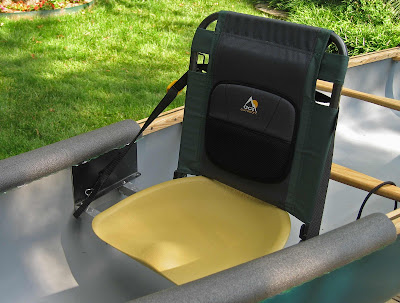In 2009 Mike, one of my brothers, needed a partner for a paddling race called the MR340. To be
in the race we had to have something to paddle. Something fast and free.
My neighbor Jamie told me that a friend had a Mad River canoe but, "it needs a little work". Upon inspection it was just a Royalex hull. The owner had 2 rotten thwarts, and a rotten seat in his shed.
He would pay for all materials, but he wanted the wooden gunnels the canoe came with.
It was 3 weeks before the race and it was considered a fast canoe. It just needed a little work.
How hard could it be right?
I needed 20', so I had to splice two pieces. I made a 10" lap joint and marine epoxied it
together with 4 screws in opposition.
I soaked the gunnels in water, bent and clamped them to the rim of the hull and let them dry.
The Royalex shell was very flexible, so before I bent the gunnels I needed the three thwarts to hold the correct shape. Luckily I had the two rotten thwarts which I copied.
Guess-timating the thwart locations and keeping the correct shape while bending the gunnels in place was tricky. Luckily my neighbor Ric, who was also in the race with another one of my brothers, gave me a
bag of spring clamps which worked great. You can never have too many clamps.
Ric gave me the old seat mount brackets off his canoe, and I riveted them to the hull. I bought some plastic tractor seats, because they were considered the most comfortable canoe seat. These I bolted to the brackets using aluminum square tubing.
It's the longest continuous paddle race in the world. The race rule of thumb is, just stay in the boat,
so butt and back comfort was a major concern.
For back rests I bought some cheap folding stadium/boat seats and cut away the fabric seat area revealing it's 2 aluminum support tubes. These I bolted to the square tube with C brackets. The folding back rests were fully adjustable, and worked well during the race.
Some reflection tape and navigation lights for the night, and the canoe was ready to go.
The race was a great experience. To me more of a mental challenge than a physical one. Endlessly following the current from wing dyke to wing dyke became tediously boring. The night was
a different story.
 |
| Jefferson City, heading into the night |
The canoe functioned well, but was not very fast. No matter how hard we paddled we could not go faster than 6 mph. The current was 3 mph, (why you just stay in the boat), but it got us to St. Charles.
View the slide show to see all the pictures







